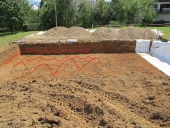John C Daley wrote:Clay is a critical component of any mix.
You cannot add portland cement to compensate for it.
Either look around your property for better soil or import it from somewhere.
Have a look at this; http://www.earthbagbuilding.com
I've talked to Owen previously and taken a few classes at cal earth. All of my understanding points to needing a binder, be it clay, lime, cement, or aspalt emulsion. Owen himself has that completely zero-stabilized zero-binding structure made entirely out of pumice. In Hunter and Kiffmeyer's book they make reference to zero-clay, zero-stabilized coral sand construction in some tropical island somewhere off.
But for me I want a binder, and since I'm short of clay and even lime reacts better with clay, I'm stuck with Portland. I've checked around, I'm in a very mountainous area. The clay forms many miles away where water carried it.






